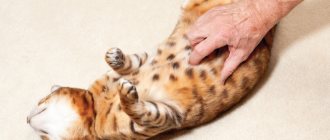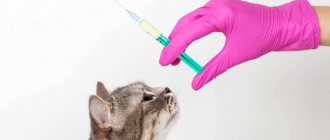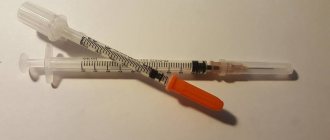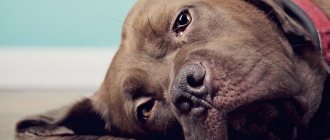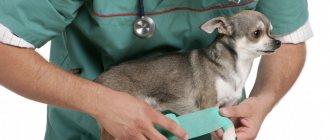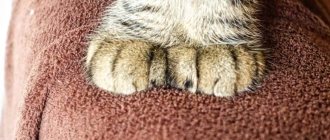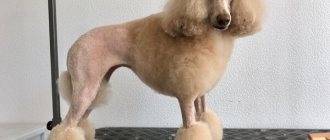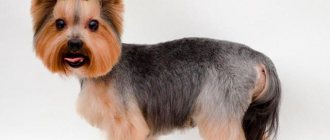Dog massage is a fairly common way to get an animal in order after an injury or simply keep it in good physical shape. The answer to the question about Why do dogs need massage?, quite simple. It is used to get rid of various diseases, rehabilitation after fractures or for prevention. You can do it from a specialist or learn the technique yourself, and please your pet regularly and for free.
Dog massage
Benefit
For the first time in their lives, dogs are introduced to massage in infancy. When a mother licks her newborn puppies, she helps them breathe. When the cubs grow up, the mother kneads their tummies. This manipulation prevents constipation.
Massage for dogs is also necessary in adulthood. This is a good means of treating and preventing diseases. The benefits of massage treatments are as follows:
- Massaging movements stimulate blood circulation. As a result, blood flows to a certain area of the body, tissue nutrition and local metabolism improves. This promotes faster healing of injuries, which is why massage is often prescribed for injuries.
- The procedure stimulates the motor nerves. Therefore, massage is necessary for paralysis and weakness of the paw muscles. This rehabilitation activity helps restore movement.
- Massage helps to relax and calm the nervous system. This procedure is useful for a dog after experiencing stress, difficult training or an exhibition.
- Massage procedures improve peristalsis and facilitate easy bowel movements.
In many cases, dog massage can be done on your own. However, if your pet is seriously ill, the procedure should be performed by a professional. Not all types of massage treatments can be done at home.
Complications
Paralysis can lead to other more serious consequences and further aggravate the general condition. These include the following:
- rapid muscle atrophy . Muscles that have lost their mass find it more difficult to become active. Therefore, without massage and physiotherapeutic procedures, the animal will never return to its normal life;
- the appearance of contractures . If the pet does not make passive movements, imitating physiological ones, then the joints gradually ossify;
- bedsores _ A long-term immobile position contributes to the appearance of areas of necrosis on tissues in contact with the floor;
- development of other diseases . Physical inactivity leads to hypostatic pneumonia and an increased risk of blood clots, which can cause death.
Indications
For what diseases is massage for dogs indicated? This procedure is effective for the following pathologies:
- diseases of the musculoskeletal system;
- injuries;
- constipation;
- inflammation and degeneration of joints;
- pain syndrome of various origins;
- neurotic disorders.
Healthy dogs should also get massages regularly. This will help your pet maintain a healthy musculoskeletal system into old age, as well as relieve stress and relax.
Symptoms of the disease
Dragging paws behind you
Clinical manifestations may vary. The rate of development of pathology also differs significantly. In some cases, the disease progresses quickly (injuries), leading to disability of the animal within a few minutes, in others it lasts for years (tumors, discopathy, etc.) The following main symptoms can be identified:
- loss of ability to move independently. The dog can walk while leaning on walls or other interior objects. In isolated forms, one or more limbs may drag after the dog along the floor or ground;
- unsteadiness of gait. The animal moves uncertainly, staggering;
- frequent stumbling. Weakened or absent muscle strength leads to decreased range of motion. The pet touches any small obstacles - stones, carpets, thresholds. An additional danger is introduced by the possibility of injury and infection (in denervated areas the immune system does not function adequately, creating a favorable environment for the proliferation of microorganisms);
- asymmetry of the body and limbs. Paralysis or paresis leads to the impossibility of movement, decreased muscle tone, which disrupts the functional and aesthetic anatomy of the animal.
Unsteady gait as a sign of paralysis
When the pain syndrome is severe, the animal is restless and rushes around the room, even if this is not completely successful. In rare cases, if the lesion is in the brain, the disease is combined with attacks of convulsive seizures. They can be limited (one limb twitches) or generalized (convulsions cover the entire body). Systemic convulsions are a dangerous phenomenon, since during them the animal’s breathing stops due to spasm of the circulatory fibers of the larynx.
Contraindications
There are times when massage is contraindicated. This procedure should not be done under the following conditions:
- fever;
- any injuries and lesions of the skin (eczema, tumors, wounds, pustules);
- bleeding;
- fresh bone injuries with severe pain;
- epilepsy;
- severe liver and kidney diseases;
- shocked.
If your dog has at least one of the listed contraindications, then refuse massage. Otherwise, the treatment procedure will do more harm than good.
Useful video
Watch this video about water rehabilitation of dogs:
Similar articles
- Stroke in a dog: first signs and symptoms, treatment...
Stroke is one of the most commonly diagnosed diseases in elderly dogs... a veterinary specialist performs a therapeutic massage on a sick animal. Read more - Treatment of the spine in a dog: diseases with which...
Difficult treatment of the spine in dogs: what can be revealed during diagnosis and how to save the dog from suffering. In second place among pathologies… Read more
- Ligament rupture in a dog (knee, cruciate, na...)
Treatment for a dog. ... For a speedy recovery, the dog undergoes physical procedures: cryotherapy, electrotherapy, massage, swimming pool, treadmill. Read more
- Constipation in a dog - what to do, what will help best for...
The problem is especially acute for dogs fed dry food. ... On the recommendation of a doctor, your pet can have a belly massage to prevent... Read more
- Pneumonia in dogs: symptoms, treatment, antibiotics...
Pneumonia develops in dogs due to various microbes entering the lungs and... the owner can massage the chest to stimulate the passage... Read more
Some tips
Before giving your dog a massage, check out the following advice from veterinarians:
- You will need a basic knowledge of canine anatomy and physiology. You can learn about the characteristics of the animal’s body from a veterinarian. You can also find this information yourself on dog breeding websites.
- During the procedure, turn your pet over to massage first one side and then the other. Try not to press on the stomach; this part of the body can only be lightly stroked. Otherwise, the abdominal organs may be damaged.
- If your pet is diagnosed with a serious illness, then it is better to entrust massage treatments to a specialist.
- If you give a preventative massage to a healthy dog, then the procedures should be regular. Try to spend at least 10 minutes on this every day. This will be a good prevention of the development of arthritis.
- If your pet is healthy, then pay attention to its reaction to the procedures. If the dog shows dissatisfaction (growls, flinches), then do not force it. You need to gradually accustom your animal to massage.
Treatment
Treatment tactics depend, first of all, on the etiology of the disease. If the cause of the deviations is fractures, dislocations or ligament ruptures, then the limb is immobilized with a plaster cast or tight bandage for a certain time (usually 3-6 weeks).
How to recognize a fracture in a dog
Neoplasms are subject to surgical excision, followed by chemotherapy to prevent the growth of metastases and tumor recurrence. In some situations where cell proliferation is unresectable, palliative radiotherapy may be prescribed. The lesion is exposed to X-rays that destroy the tumor.
For bacterial or viral infectious and inflammatory processes, antimicrobial and antiviral agents are prescribed. The dosage regimen is indicated in the table.
Table 1. Drug treatment of infections due to paralysis in dogs
| Name | Dosage | Frequency of application | Duration of treatment | Spectrum of action | Method of administration |
| Amoxicillin | 20 mg/kg | 2 times a day | 4-8 days | Bacteria | With food |
| Azithromycin | 4 mg/kg | Every 24 hours | 10 days | Bacteria | With food |
| Neomycin | 15 mg/kg | 1 per day | 10 days | Bacteria | With food |
Ribotan | 2 ml | Every 8-12 hours | 3-5 days | Viruses | Subcutaneous/intramuscular |
Spinal lesions, as a rule, are not radically corrected and are subject to symptomatic therapy. An excellent tool for reducing the activity of the inflammatory process (especially of an autoimmune nature) are systemic glucocorticosteroids. For example, Methylprednisolone (1 mg/kg 2 times a day).
In order to reduce the severity of pain, the use of non-narcotic analgesics is indicated. Nonsteroidal anti-inflammatory drugs are excellent: Ketonal (1 mg/kg body weight per day), Vedaprofen (0.5 mg/kg 2 times a day, but not more than 10 mg per day). This group of drugs has not only an analgesic, but also an anti-inflammatory effect, helping to reduce and delineate the source of inflammation. The duration of treatment, for safety reasons, should not exceed 14 days.
The drug Ketonal in capsules
Increased load on the muscles due to impaired innervation of the limbs always leads to muscle overload. Antispasmodics are indicated to reduce spasm and tension. The banal No-shpa or Baralgin . Dose – 1 tablet per 10 kg of dog weight per day. The course of treatment is until the symptoms disappear completely.
Baralgin tablets
The doctor can also prescribe multivitamin preparations that necessarily contain B1, B12 and PP. One of these medications is the vitamin supplement “Vitamins”. The duration of therapy is 2 months, and the daily dose for a weight less than 10 kg is 3 tablets, from 10 to 20 kg - 5-6, from 30 to 40 - 7-8, and for a body weight over 40 kg - 10 tablets.
Attention! The use of any drug should be carried out only after consultation with a veterinarian on his recommendation. Self-treatment without undergoing examination in a clinic is fraught with life-threatening consequences.
We do a general massage
Veterinarians recommend general massage to prevent disease. The methodology for carrying it out is as follows:
- Cover a hard surface with a soft cloth. Place your pet on it and stroke it from head to back.
- Massage the back first with your fingers and then with your palms. Gently knead the skin, trying not to put pressure on the spinal column.
- Focus on the sacrum. Massaging this area prevents joint diseases.
- Rub your paws from top to bottom. Then bend and straighten each finger.
- Gently pat your pet's belly. At the same time, avoid sharp pressure.
- Now move on to massaging the muzzle. Take the cheeks with your fingers. Lift them up and then lower them down. Stroke the chin, as well as the area around the nose and eyes.
Complete the procedure by stroking the tail from base to tip.
Relieving pain
How to massage a dog if something hurts your pet? The procedure technique is as follows:
- Place the dog on a blanket or the floor, make petting movements and talk to the dog in a soft voice.
- Rub your shoulders, neck and back in circular motions, as if you were kneading dough. Do not put too much pressure on your body, as this may increase the pain.
- Gently stretch your paw muscles. Move from their base down. Don't forget to massage your fingers.
- Direct impact on the source of pain is prohibited. You can only stroke and knead the muscles around the sore spot. This will help improve blood circulation and reduce discomfort. Be especially careful if your dog suffers from cancer. Try not to touch the tumors, this may provoke their growth.
- Complete the procedure by lightly stroking the entire body from head to tail and each paw.
Rules for performing procedures
To help your pet and not harm his health, you should follow some rules. The atmosphere when working with a dog should be quiet, there should be no extraneous sounds.
You can use calm music. If an animal wants to look around, then it is worth giving him this opportunity.
You should massage your pet at least two hours after feeding. It is advisable to wash the dog or at least clean the skin of twigs and dirt. During the procedures, you can talk to the animal.
Helping the dog relax
A relaxing massage for dogs is essential to calm the nervous system and relieve stress. This procedure is useful to do when your pet is frightened by something or after a hard day. In this case, the main attention should be paid to the area of the head, ears and back.
Follow the following sequence:
- Pet your pet's entire body. At the same time, try to speak kindly to the dog. Pat the dog by the scruff of the neck. This will help the animal calm down and relax.
- Start the massage from the neck. Massage the area in a downward circular motion. Do not press too hard, remember that there are many blood vessels in this area. Massage the ears and the area around them, but very gently.
- Then move to the shoulder girdle. Make the same circular movements. Gradually move towards the tail.
This completes the procedure. Finally, you can stretch the ponytail a little or turn it three times in different directions. But watch your pet's reaction. Some dogs find such manipulations relaxing, but not all dogs like having their tail touched.
Prevention
Any disease can be prevented. To prevent your pet from encountering such a serious problem, you should follow a few simple rules:
- early activation of the animal. From 1-2 months he should be allowed outside and allowed frequent contact with dogs of his age;
From the first months, it is important to accustom puppies to an active lifestyle.
- making time for rest. If your pet wants to sleep, do not disturb him;
- prevention of going down stairs until six months of age. It is better to carry small puppies in your arms, this will prevent injuries and fractures;
- undergo regular examination (including x-rays) for breeds at high risk of paralysis;
- adherence to diet. The food entering the dog’s body must be complete in qualitative and quantitative proportions, given in accordance with the preferences of the breed and age;
- exclude exposure to cold (air conditioning, tiles, drafts). The animal's permanent place of residence must be warm;
- regular sanitary cleaning and washing of all pet’s personal belongings without the use of hazardous chemicals.
Once every six months, the dog must be taken to the veterinarian for examination.
Massaging the limbs
Massage of the hind legs of dogs is done for paralysis and weakness of the muscles of the limbs. This procedure is an important part of rehabilitation. It stimulates nerve endings and develops muscles. This helps restore normal limb mobility.
To achieve the desired effect, your dog's paws must be massaged regularly. Treatment should continue for at least 20 minutes a day. To achieve the result, about 20 procedures will be required. Then they take a break for 14 days and repeat the sessions.
How to massage your dog's paws? It is necessary to give preference to kneading and vibration effects. This helps stimulate and restore nerves and muscles.
Use the following massage technique:
- Pet the dog's entire body. Try not to lift your hands while doing this. Your pet should be completely relaxed and calm.
- Gently pat the paw. Move from the base to the heels. Then slowly bend and straighten the limb. Repeat this movement 5 times.
- Massage your paw in a circular motion. First move to the inner surface of the limb, and then to the outer. Repeat the massage movements three times.
- Rub your paw muscles well. Gradually increase the intensity of the impact, but do not overdo it. Gently massage your heels and spaces between your toes.
After massaging one paw, move on to the other. Using this technique, you can massage both the hind and forelimbs. If you repeat the sessions regularly, your paws will regain strength. Gradually, your pet will learn to walk again.
Procedures for paralysis of the paws
Paralysis of the limbs is a serious problem. Massage for this disease complements rehabilitation.
Vibrations and stroking are mainly used during the procedure. It lasts for 15-20 minutes. Typically course procedures last 15-20 days.
Caring for a puppy: a reminder for a novice dog breederHow to protect your dog from ticks: the best ways to protect yourself from tick bites
Toothpaste for dogs - review of manufacturers and the best products for cleaning dogs’ teeth at home (85 photos and videos)
